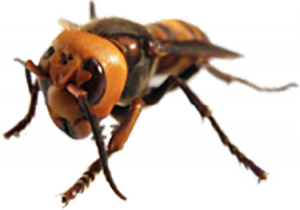Written by Timothy Lawrence, Associate Professor and County Director, WSU Extension, Island County. April 2020
 It seems like every few years, the beekeeping industry is hit with another significant calamity. Those of us who work and study the honey bee, we live in constant concern for the myriad of threats that exist. In the 1980s, the varroa mite forever changed the beekeeping industry and the pollination services they provide. For the last ten years, the USDA has supported surveys of honey bee colonies looking for the presence of two Asian mites, both in the genus Tropilaelaps. Fortunately, those surveys have come back negative. However, two different Asian pests have found their way to North America. The Asian giant hornets, Vespa mandarinia in Whatcom County and Vespa ducalis in British Columbia. If either of these pests become established, it could present an impact perhaps not at the same level as Varroa or Tropilaelaps, but severe enough to cause significant disruptions. Also, the hornet will generate a public health crisis as well. According to world-renowned authority Justin Schmidt, V. mandarinia, is the most venomous and intimidating insect in the world. It is unknown how well established these hornets are in either location. The Washington State Department of Agriculture is determined to find out and eliminate them before they are established. With the queens coming out of hibernation in late March and early April, WSDA is gearing up to assess the extent of the Asian hornet infestation. The USDA, WSDA, and WSU are working with local beekeepers, farmers, and the public to be on the lookout for this pest. A new WSU Factsheet outlines both concerns about the hornet found are Washington V. mandarinia and precautions everyone should know if they encounter this massive hornet. WSU has also developed a quick information card to help get out the word. WSDA has set up a website for information about the hornet and where to report sightings.
It seems like every few years, the beekeeping industry is hit with another significant calamity. Those of us who work and study the honey bee, we live in constant concern for the myriad of threats that exist. In the 1980s, the varroa mite forever changed the beekeeping industry and the pollination services they provide. For the last ten years, the USDA has supported surveys of honey bee colonies looking for the presence of two Asian mites, both in the genus Tropilaelaps. Fortunately, those surveys have come back negative. However, two different Asian pests have found their way to North America. The Asian giant hornets, Vespa mandarinia in Whatcom County and Vespa ducalis in British Columbia. If either of these pests become established, it could present an impact perhaps not at the same level as Varroa or Tropilaelaps, but severe enough to cause significant disruptions. Also, the hornet will generate a public health crisis as well. According to world-renowned authority Justin Schmidt, V. mandarinia, is the most venomous and intimidating insect in the world. It is unknown how well established these hornets are in either location. The Washington State Department of Agriculture is determined to find out and eliminate them before they are established. With the queens coming out of hibernation in late March and early April, WSDA is gearing up to assess the extent of the Asian hornet infestation. The USDA, WSDA, and WSU are working with local beekeepers, farmers, and the public to be on the lookout for this pest. A new WSU Factsheet outlines both concerns about the hornet found are Washington V. mandarinia and precautions everyone should know if they encounter this massive hornet. WSU has also developed a quick information card to help get out the word. WSDA has set up a website for information about the hornet and where to report sightings.
Resources
- WSU Extension Factsheet Giant Asian Hornet Factsheet
- WSU CAHNRS News Article WSU scientists enlist citizens in hunt for giant, bee-killing hornet
- Report Giant Asian Hornet Sightings to WSDA
Treefruit.wsu.edu articles may only be republished with prior author permission © Washington State University. Republished articles with permission must include: “Originally published by Washington State Tree Fruit Extension Fruit Matters at treefruit.wsu.edu” along with author(s) name, and a link to the original article.